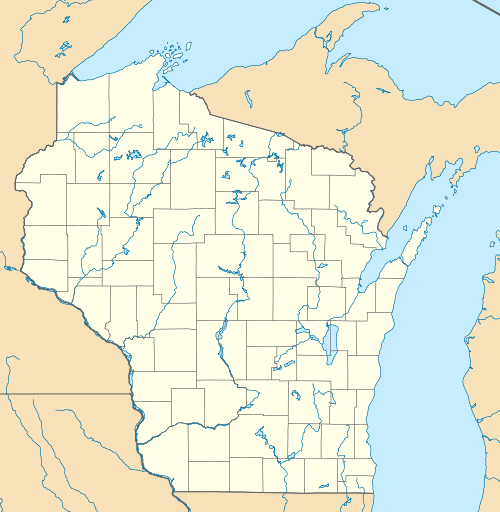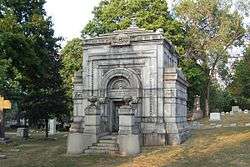Forest Home Cemetery
|
Forest Home Cemetery and Chapel | |
|
Landmark Chapel | |
  | |
| Location | 2405 Forest Home Ave., Milwaukee, Wisconsin |
|---|---|
| Coordinates | 42°59′53″N 87°56′35″W / 42.99806°N 87.94306°WCoordinates: 42°59′53″N 87°56′35″W / 42.99806°N 87.94306°W |
| Area | 198.5 acres (80.3 ha) |
| Built | 1850 |
| Architect | Lapham, Increase A.; Multiple |
| Architectural style | Gothic |
| NRHP Reference # | [1] |
| Added to NRHP | November 03, 1980 |

Forest Home Cemetery located in the Lincoln Village neighborhood of Milwaukee, Wisconsin is the final resting place of many of the city's famed beer barons, politicians and social elite. Both the cemetery and its Landmark Chapel are listed on the National Register of Historic Places and were declared a Milwaukee Landmark in 1973.
The cemetery is run by a non-profit organization held in public trust. Profits from each sale are reinvested to insure continual care of the buildings and land. Its Victorian landscape contains over 300 species of trees, along with many ornate statues, crypts and monuments.
History
A committee appointed by members of St. Paul's Episcopal Church in 1847 established Forest Home Cemetery on what would later become Milwaukee's south side. When the land was selected it was located nearly two miles outside of the city limits along the newly built Janesville Plank Road (now Forest Home Avenue), in an area believed to be far enough from urban development to remain rural.[2] The 72 acres (290,000 m2) that were purchased in 1850 quickly grew to nearly 200 acres (0.81 km2) by the start of the 20th century. Orville Cadwell was the first burial on August 5, 1850 but was soon joined by others due to an outbreak of cholera in the city.
This location was dotted by Paleo Indian burial mounds and intersected a large collection of effigy mounds known to settlers as the Indian Fields. It contained over sixty earthworks which were catalogued by pioneer scientist Increase A. Lapham, including a rare intaglio of a panther, none of which remains today. An Indian village populated the corner near what is now Lincoln Avenue that grew corn on the hills.[3] They most likely chose this location due to its proximity to the Kinnickinnic River.
Construction of the Gothic style Landmark Chapel started in 1890 and took two years to complete. It was designed by architects George Ferry & Alfred Clas and built using Lake Superior Sandstone, a dark red sandstone found near the Apostle Islands in Lake Superior. A leaded glass conservatory containing decades-old tropical plants extends from the north and south sides of the nave.[4]
Modern improvements within Forest Home Cemetery include two large mausoleums. The Halls of History is an indoor temperature controlled mausoleum and community center. Along with the columbarium and crypts it houses, the center contains a number of permanent and changing exhibits that educate visitors about the history of Milwaukee and over 100 of its people. It is open for walk-ins during office hours. Adjacent to this is a large terraced outdoor mausoleum called Chapel Gardens. It contains above ground burials in porticos set by ornate colonnades, statues, and rose gardens.
Notable interments







Forest Home Cemetery is home to 28 Milwaukee mayors, seven Wisconsin governors, noted industrialists and over 110,000 burials.[5] The Newhall House Monument is a mass grave for 64 people of the Newhall House fire of 1883, in which 71 individuals (43 unidentified) died.
- Gerhard Bading, mayor and U.S. Minister to Ecuador[6]
- Sherburn Becker, known as the "boy mayor" of Milwaukee[6]
- Meta Schlichting Berger, female socialist organizer and advocate for improved public schooling systems[6]
- Victor Berger, newspaper editor and founding member of the Socialist Party of America
- Jacob Best, founder of what became the Pabst Brewing Company
- Valentin Blatz, founder of the Valentin Blatz Brewing Company
- Sherman Booth, newspaper editor and abolitionist
- Lynde Bradley, co-founder of the Allen-Bradley corporation
- James Brown, politician and first attorney general of Wisconsin
- Thomas H. Brown, twice named Mayor of Milwaukee[6]
- George Brumder, newspaper publisher (largest circulation of German language papers in the U.S.)
- Ammi R. Butler, Mayor of Milwaukee[6]
- Horace Chase, politician who served as mayor of Milwaukee[6]
- Hans Crocker, editor of Milwaukee's first newspaper and politician[6]
- Lysander Cutler, politician and Union Army general during the American Civil War
- Arthur Davidson, One of the four original founders of the Harley-Davidson Motorcycle Company
- William Davidson, One of the four original founders of the Harley-Davidson Motorcycle Company
- Walter Davidson, President and co-founder of the Harley-Davidson Motorcycle Company
- William Disch, member of the Wisconsin Legislature
- Barney Augustus Eaton, member of the Wisconsin Legislature
- Susan Stuart Frackelton, painter, specializing in painting ceramics[6]
- Ezekiel Gillespie, a Wisconsin agitator for equal rights for African Americans[7]
- William T. Green, Milwaukee's first black lawyer and civil rights activist
- Charles Hammersley, 1930 candidate for governor
- Harrison Carroll Hobart, Union Army general
- Louise Phelps Kellogg, historian, writer, and educator[6]
- Byron Kilbourn, American surveyor, railroad executive and co-founder of the City of Milwaukee[6]
- Charles King, U.S. General and distinguished writer
- Abner Kirby, businessman and mayor of Milwaukee[6]
- August Krug, founder of what became the Joseph Schlitz Brewing Company
- Increase A. Lapham, author, scientist, and early American naturalist
- William Lynde, lawyer and Wisconsin politician, Mayor of Milwaukee[6]
- Harrison Ludington, Milwaukee mayor and governor of Wisconsin[6]
- Alfred Lunt & Lynn Fontanne, famous award winning husband and wife Broadway acting team
- Francis McGovern, American politician and Wisconsin governor[6]
- Edmund T. Melms, American politician
- Andrew Miller, justice of the territorial Wisconsin Supreme Court
- Alexander Mitchell, wealthy banking magnate and Mitchell family patriarch
- Billy Mitchell, U.S. Army general regarded as the father of the U.S. Air Force
- John Mitchell, Senator and father of General Billy Mitchell
- Frederick Pabst, brewing magnate of Pabst Brewing Company fame
- Henry Payne, U.S. Postmaster General
- Emanuel Philipp, governor of Wisconsin[6]
- William Smith, politician and co-founder of Roundy's supermarket chain[6]
- George Peck, newspaper publisher, mayor of Milwaukee and governor of Wisconsin[6]
- Ole Petersen, founder of Methodism in Norway
- John Rugee, Wisconsin politician
- Joseph Schlitz (cenotaph), brewing magnate of the now defunct Joseph Schlitz Brewing Company
- Christopher Sholes, inventor of the first practical typewriter with its QWERTY key layout
- Fred W. Springer, Wisconsin politician
- John M. Stowell, Mayor of Milwaukee[6]
- Adonis Terry, 19th century Major League Baseball player.
- Don Upham, United States Attorney and two-term Milwaukee mayor[8]
- George Walker, early settler and co-founder of the City of Milwaukee[6]
- Isaac Walker, U.S. Senator and younger brother of George Walker
- Emil Wallber, Mayor during the Bay View Tragedy[6]
- Oscar Werwath, founder of the Milwaukee School of Engineering
- Frederick Charles Winkler, Union Army general
- Carl Zeidler (cenotaph), brother to Frank Zeidler and Milwaukee's "singing mayor"
- Frank Zeidler, three term socialist mayor of Milwaukee and 1976 United States Presidential Candidate
- Two British Commonwealth war graves of World War I, a Canadian Army soldier and a Royal Air Force Flight Cadet.[9]
See also
References
- ↑ National Park Service (2009-03-13). "National Register Information System". National Register of Historic Places. National Park Service.
- ↑ Sandra Ackerman. Milwaukee Then and Now. San Diego, California: Thunder Bay Press, 2004.
- ↑ John Gurda. The Making of Milwaukee. Milwaukee, Wisconsin: Milwaukee County Historical Society, 1999.
- ↑ Chapel at Forest Home Cemetery, UWM Libraries Digital Collections, October 30, 2010.
- ↑ 150 years of city's history live on in cemetery's gravestones, Milwaukee Journal Sentinel, August 13, 2000.
- 1 2 3 4 5 6 7 8 9 10 11 12 13 14 15 16 17 18 19 20 "Historical People". Forest Home Cemetery. Retrieved May 16, 2014.
- ↑ http://milwaukeehistoryblog.wordpress.com/2013/02/18/ezekiel-gillespie-the-man-who-wanted-to-vote/
- ↑ "Don Alonzo Joshua Upham (1809 to 1877)". Forest Home Cemetery. Retrieved May 16, 2014.
- ↑ CWGC Cemetery report, detail from casualty record.
Further reading
- The Forest Home Cemetery, Milwaukee, Wis., with a map of the grounds by Silas Chapman. 1871.
- Silent City: A History of Forest Home Cemetery by John Gurda. 2000.
External links
| Wikimedia Commons has media related to Forest Home Cemetery. |
- Forest Home Cemetery
- Cemetery marks its 150th anniversary
- Forest Home Cemetery Burials and Interments
- Historic American Landscapes Survey (HALS) No. WI-2-A, "Forest Home Cemetery, Soldiers Lot, 2405 West Forest Home Avenue, Milwaukee, Milwaukee County, WI", 5 photos, 1 photo caption page
